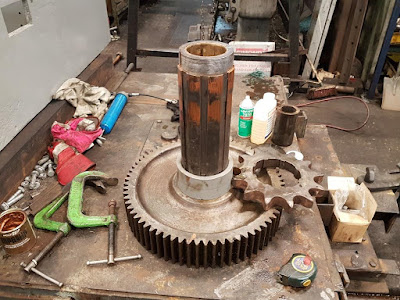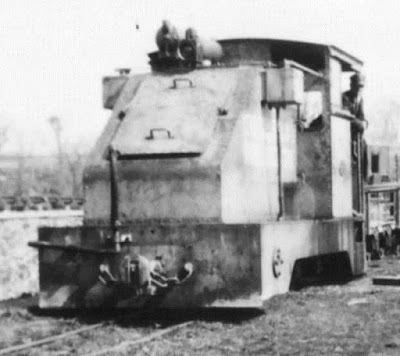(The front frame stretchers are offset; the coupling is in the middle of the buffer beam!)
The lay shaft is a huge lump of steel which runs across the full width of the loco at the front. It is static and the two prominent ‘bearings’ in the frames support the fixed shaft. The rotating component is the ‘sprocket sleeve’. This is the layshaft. The sprocket sleeve sits on the left hand (polished) end. The milled flat on the shaft feeds oil to the Sumet metal (bronze) bearings fitted inside the sprocket sleeve.
The sprocket sleeve itself
The splined sprocket sleeve carries the large gear wheel, driven by the gearbox, the drive chain sprocket & the transmission brake drum. While the drive chain sprocket is machined to fit the splines the gear wheel and transmission brake are secured by keys. To re-gauge the loco the position of the drive sprocket can be varied by inserting different spacers onto the sprocket sleeve.

When first built the frames on KS4415 were continuous on both sides. Making the front section of the frames removable makes a lot of sense when it comes to installing the sprocket sleeve onto the layshaft. Dave High ponders how to make the sling slide through the footplating. Was the frame modification made in 1929 to facilitate re-gauging to 3’ for use at Castlederg?

The spectacular Thrackway washer which secures the layshaft to the end bearings.
The sprocket spindle before & after.
(Gearbox still to restore. Transmission brake pads to re-fit)



All wheels turned

Chains delivered

Felt seals manufactured for axleboxes
Axleboxes assembled & fitted to the radius rods.
(The hind wheelset is on the left, this has only one chain sprocket
which is on the other side, out of camera shot)
A chance for the wheelsets to shine and re-create two images from "15/- change".
(Unlike the "15/- change" images, the sub frames have already been attached to the main frames.
The hollow box section in the spring clamps was a temporary measure to hold the axleboxes level while the chain tension was being adjusted)
With the springs fitted and the box section removed the wheelsets do their own thing
as Matty Wolstenholme & Ed Ford propel them towards the frames.
Having briefly shone, the wheelsets become accustomed to life in the shade.
The clevis which attaches the rear radius rod to the frame.
(This section of frame replaced as part of the restoration)


Dragbox installation

Big nuts.
Although the project uses imperial fastenings,
the modern dragbox has been assembled with metric set screws.
Chopper coupling fitted
The ‘split face’ chopper couplings are recovered old units, similar in appearance those fitted in early 1929. Ultimately the loco will be fitted with side chains too.

Brake gear erected; the brake blocks have subsequently been fitted.
The completed frame assembly.
The handbrake stanchion bolts to the cast iron cab floor,
The handbrake stanchion bolts to the cast iron cab floor,
which is supported by two further upright castings


















No comments:
Post a Comment